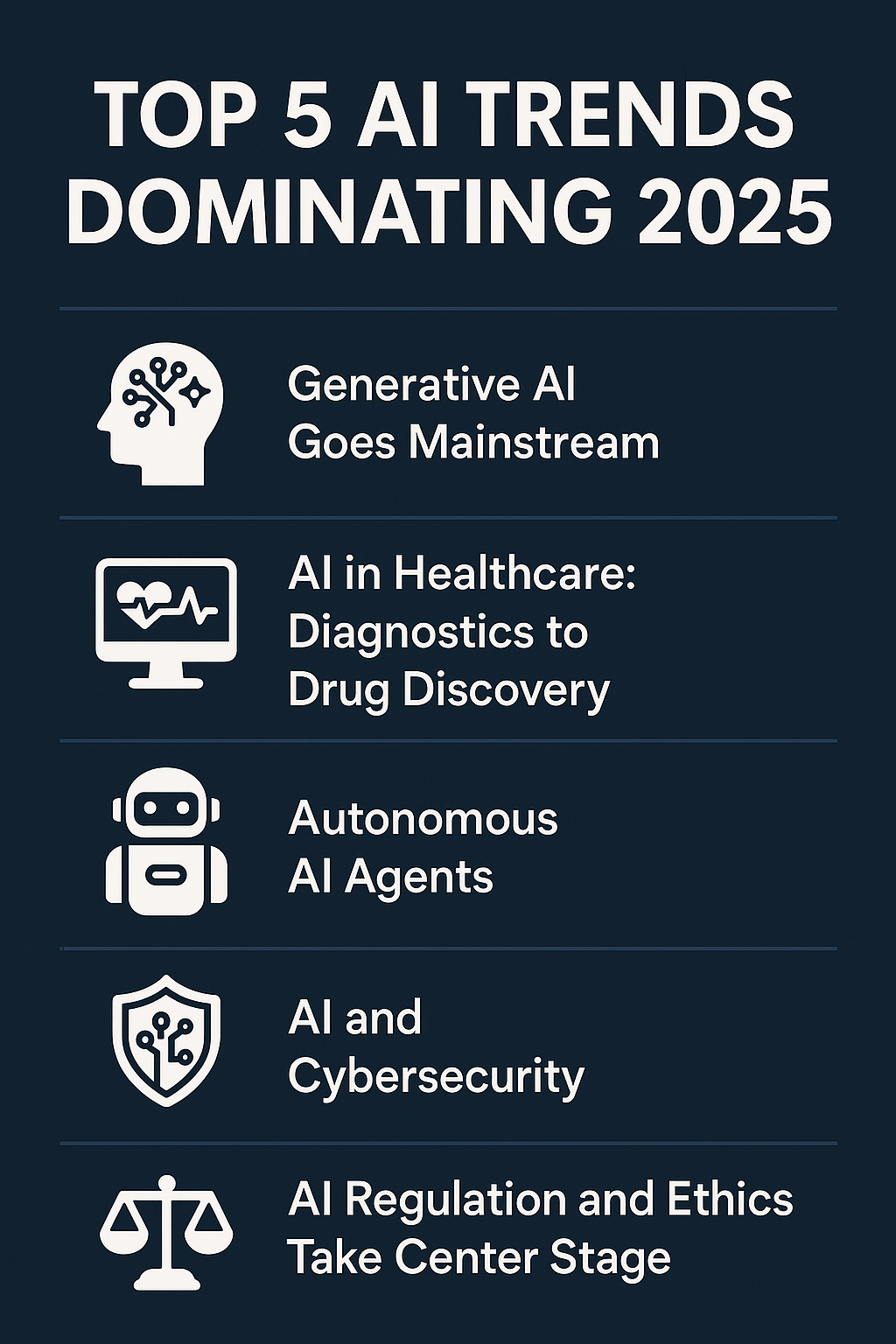Introduction
Top 5 AI Trends Dominating 2025. Artificial Intelligence (AI) has been reshaping our world at an unprecedented pace. As we step deeper into 2025, it’s clear that AI is no longer a futuristic concept—it’s a present-day reality influencing every major industry. From healthcare and finance to entertainment and education, AI is revolutionizing the way we work, live, and interact with technology. In this blog, we’ll explore the top 5 AI trends that are dominating 2025, helping businesses stay competitive and users get smarter, faster, and more intuitive digital experiences.
Table of Contents
1. Generative AI Goes Mainstream
Generative AI, once limited to research labs and creative tools, has become mainstream in 2025. Technologies like GPT-4, DALL·E, and others have evolved into enterprise-ready tools used across marketing, software development, entertainment, and customer service.
Companies are now embedding generative AI in their daily workflows. For example:
- Content creation: Tools like ChatGPT assist writers, marketers, and educators in drafting content quickly and effectively.
- Code generation: Developers rely on AI tools like GitHub Copilot to write and debug code faster.
- Design and media: AI-generated videos, logos, and music are now used widely in advertising and entertainment.
Moreover, personalization has reached new heights. AI not only creates content—it tailors it to individual preferences in real-time, resulting in hyper-personalized user experiences.
2. AI in Healthcare: Diagnostics to Drug Discovery
AI has had a transformative impact on healthcare, and in 2025, that transformation is accelerating. AI-driven diagnostics, predictive analytics, and drug discovery are saving lives and reducing costs.
Key advancements include:
- AI Diagnostics: Tools like DeepMind’s AlphaFold are now commonplace, accurately predicting protein structures, revolutionizing treatment planning.
- Remote Monitoring: Wearables and AI health assistants monitor patients’ vitals in real-time, sending alerts to healthcare professionals for early interventions.
- AI in Drug Development: AI reduces the time to develop new medications from years to months by simulating drug interactions before physical trials.
Healthcare providers are adopting these technologies rapidly to offer personalized medicine and predictive treatments. The integration of AI and Internet of Medical Things (IoMT) also ensures continuous, data-driven care for patients, particularly those with chronic illnesses.
3. Autonomous AI Agents
Autonomous agents—AI systems capable of making independent decisions and taking action without human intervention—are no longer theoretical. In 2025, they’re becoming practical tools for business automation and customer engagement.
For instance:
- Customer support: AI agents handle complex customer queries across platforms, freeing up human agents for more critical issues.
- Supply chain: Autonomous agents optimize logistics, handle inventory reordering, and manage vendor negotiations.
- Personal productivity: AI agents like AutoGPT and BabyAGI plan schedules, write emails, and complete tasks with minimal human input.
These agents are growing more intelligent, capable of understanding context, remembering preferences, and learning from interactions. This evolution signals a shift toward a more autonomous digital workforce, reducing costs and increasing productivity.
Read more about autonomous AI from this VentureBeat article.
4. AI and Cybersecurity: Fighting Fire with Fire
With the rise of AI tools comes a surge in AI-driven cyber threats. In 2025, cybersecurity is increasingly powered by AI—both defensively and offensively.
Here’s how:
- Threat detection: AI models detect anomalies and flag suspicious activities in real-time, identifying zero-day threats and insider attacks faster than traditional systems.
- Automated response: AI not only detects threats but also responds by isolating systems, terminating malicious processes, and alerting teams immediately.
- Adversarial AI: On the flip side, cybercriminals are using AI to craft more convincing phishing attacks, deepfakes, and malware.
To counter this, organizations are turning to advanced AI-based security systems that learn and adapt continuously. Governments and enterprises alike are investing in AI-driven threat intelligence platforms to stay ahead of malicious actors.
5. AI Regulation and Ethics Take Center Stage
With AI systems growing more powerful and deeply integrated into society, ethical considerations and regulations are now top priorities. In 2025, several global initiatives have emerged to ensure responsible AI development and deployment.
Key focus areas include:
- Bias and Fairness: Tools are being developed to audit AI models for bias and ensure fair outcomes across demographics.
- Transparency: AI developers are now required in many regions to disclose how their models work, what data they use, and how decisions are made.
- Regulation: The EU’s AI Act and similar regulations in other countries are setting the global tone for safe AI usage.
Developers, businesses, and governments are working together to ensure that AI technologies benefit everyone—without reinforcing inequality or privacy violations.
For further reading, check out the European Commission’s AI regulations.
Conclusion
The AI landscape in 2025 is dynamic, powerful, and transformative. From generative AI and autonomous agents to healthcare breakthroughs and cybersecurity, AI is shaping the next era of human progress. But as AI’s power grows, so does our responsibility to use it wisely.
These top 5 AI trends aren’t just technological marvels—they represent the future of how we work, learn, communicate, and live. Whether you’re a business leader, developer, or just a curious enthusiast, staying updated on these trends is crucial.
As AI continues to evolve, so should our understanding of its impact. By embracing innovation while prioritizing ethics and responsibility, we can ensure a future where AI serves humanity—not the other way around.
Find more AI and ML content at:
https://allinsightlab.com/category/ai-machine-learning/

